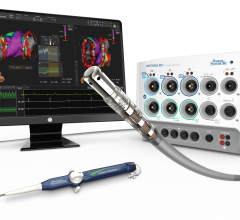October 8, 2010 – New features in the 2.0 version of the Acuson S2000 ultrasound system released today cover the entire continuum of care for vascular and cardiac imaging.
October 7, 2010 – The Superior Court of Massachusetts has ruled against LightLab Imaging in the company’s optical coherence tomography (OCT) trade secret case against Volcano and its wholly owned subsidiary, Axsun Technologies. LightLab Imaging is a wholly owned subsidiary of St. Jude Medical.
October 7, 2010 – Cardiopulmonary resuscitation (CPR) just keeps getting simpler. The October 2010 issue of the Harvard Health Letter reports that the process has been further simplified.
SPONSORED CONTENT — Studycast is a comprehensive imaging workflow system that allows healthcare professionals to work ...
October 7, 2010 - Taking medication at night instead of in the morning significantly increases efficacy in keeping blood pressure within a healthy range, according to a new study in Chronobiology International. Additionally, taking medication at night offers extra protection against heart attacks, strokes and other types of cardiovascular diseases.
October 6, 2010 – A new statement from the American Heart Association says arteriotomy closure devices are reasonable to use, but their benefits should be weighed against the risk of complications.
October 6, 2010 – Physicians have prescribed more than 30,000 wearable defibrillator vests for patients at high risk of sudden cardiac arrest (SCA). The LifeVest Wearable Defibrillator, by Zoll Medical, gives a physician time to assess the patient’s long-term arrhythmic risk and make appropriate plans.
Providing exceptional cardiovascular care for patients to achieve the best possible outcomes is the number one goal for ...
October 6, 2010 - MD Buyline has announced the highest user-ranked vendors for Q3 2010. Philips Healthcare achieved top ratings in two categories (PACS and cardiac cath lab) with the highest user activity for the second quarter in a row. Toshiba America Medical Systems also earned top ratings in diagnostic ultrasound and cardiac cath lab for the second consecutive quarter as well.
October 5, 2010 - The 37th annual VEITHsymposium, for vascular disease specialists, will be held Nov. 17 – 21 at the Hilton New York. The five-day event will feature more than 450 rapid-fire presentations from world-renowned vascular specialists with emphasis on the latest advances, changing concepts in diagnosis and management, pressing controversies, and new techniques.
October 5, 2010 – Edwards Lifesciences has opened a new 300,000-square-foot facility in Draper, Utah, allowing the company to significantly expand its manufacturing and development capabilities, especially in the transcatheter valve space.
Cardiac positron emission tomography (PET) is growing in popularity among cardiologists because it provides the ability ...
October 5, 2010 – Data from a prospective study show physicians may benefit from knowing complication rates associated with pacemaker or implantable cardioverter defibrillator (ICD) generator replacement and upgrade procedures. Results from the REPLACE Registry also established new benchmarks for making electrophysiology (EP) device replacement decisions.
October 5, 2010 – Rapid electronic review of children’s heart images by remote specialists can allow for earlier diagnosis and treatment of potentially serious pediatric heart problems. A new study by researchers from Children’s Mercy Hospitals and Clinics found that telemedicine can help children who are far from a specialized medical center.
October 5, 2010 – After a period of capital budget cuts and freezes, hospitals are seeing a thaw in capital expenditures, according to a survey published in the Premier healthcare alliance’s September 2010 Economic Outlook analysis.
When performing radiofrequency (RF) ablation to treat cardiac arrhythmia, medical professionals must balance the safety ...
October 5, 2010 – A U.S. clinical study evaluating the CrossBoss and Stingray catheters in treating chronically occluded coronary arteries concluded in August and Bridgepoint Medical has asked the Food and Drug Administration (FDA) to expand the indication for the devices.
October 4, 2010 – Germany will reimburse patients who have a left atrial appendage closure procedure in 2011. The 2011 G-DRG (German Diagnosis Related Group) catalog, recently published on the InEK website, adds the left atrial appendage closure procedure to an existing G-DRG code.
October 4, 2010 - Johnson and Johnson has completed the acquisition of Micrus Endovascular, a developer and manufacturer of minimally invasive devices for hemorrhagic and ischemic stroke. The agreement was first announced on July 12, 2010.


 October 08, 2010
October 08, 2010












